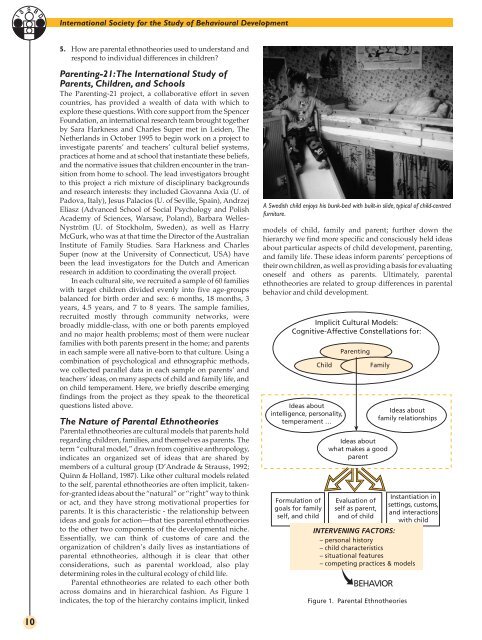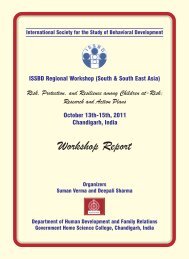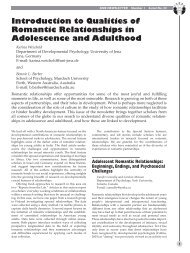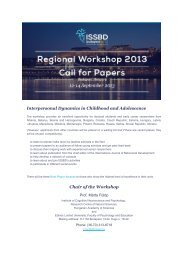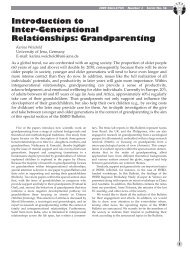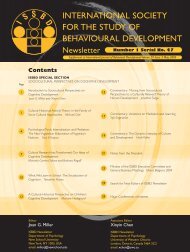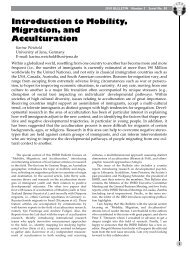Culture and Parenting - International Society for the Study of ...
Culture and Parenting - International Society for the Study of ...
Culture and Parenting - International Society for the Study of ...
Create successful ePaper yourself
Turn your PDF publications into a flip-book with our unique Google optimized e-Paper software.
S<br />
I<br />
S<br />
B<br />
D<br />
<strong>International</strong> <strong>Society</strong> <strong>for</strong> <strong>the</strong> <strong>Study</strong> <strong>of</strong> Behavioural Development<br />
5. How are parental ethno<strong>the</strong>ories used to underst<strong>and</strong> <strong>and</strong><br />
respond to individual differences in children?<br />
<strong>Parenting</strong>-21:The <strong>International</strong> <strong>Study</strong> <strong>of</strong><br />
Parents, Children, <strong>and</strong> Schools<br />
The <strong>Parenting</strong>-21 project, a collaborative ef<strong>for</strong>t in seven<br />
countries, has provided a wealth <strong>of</strong> data with which to<br />
explore <strong>the</strong>se questions. With core support from <strong>the</strong> Spencer<br />
Foundation, an international research team brought toge<strong>the</strong>r<br />
by Sara Harkness <strong>and</strong> Charles Super met in Leiden, The<br />
Ne<strong>the</strong>rl<strong>and</strong>s in October 1995 to begin work on a project to<br />
investigate parents’ <strong>and</strong> teachers’ cultural belief systems,<br />
practices at home <strong>and</strong> at school that instantiate <strong>the</strong>se beliefs,<br />
<strong>and</strong> <strong>the</strong> normative issues that children encounter in <strong>the</strong> transition<br />
from home to school. The lead investigators brought<br />
to this project a rich mixture <strong>of</strong> disciplinary backgrounds<br />
<strong>and</strong> research interests: <strong>the</strong>y included Giovanna Axia (U. <strong>of</strong><br />
Padova, Italy), Jesus Palacios (U. <strong>of</strong> Seville, Spain), Andrzej<br />
Eliasz (Advanced School <strong>of</strong> Social Psychology <strong>and</strong> Polish<br />
Academy <strong>of</strong> Sciences, Warsaw, Pol<strong>and</strong>), Barbara Welles-<br />
Nyström (U. <strong>of</strong> Stockholm, Sweden), as well as Harry<br />
McGurk, who was at that time <strong>the</strong> Director <strong>of</strong> <strong>the</strong> Australian<br />
Institute <strong>of</strong> Family Studies. Sara Harkness <strong>and</strong> Charles<br />
Super (now at <strong>the</strong> University <strong>of</strong> Connecticut, USA) have<br />
been <strong>the</strong> lead investigators <strong>for</strong> <strong>the</strong> Dutch <strong>and</strong> American<br />
research in addition to coordinating <strong>the</strong> overall project.<br />
In each cultural site, we recruited a sample <strong>of</strong> 60 families<br />
with target children divided evenly into five age-groups<br />
balanced <strong>for</strong> birth order <strong>and</strong> sex: 6 months, 18 months, 3<br />
years, 4.5 years, <strong>and</strong> 7 to 8 years. The sample families,<br />
recruited mostly through community networks, were<br />
broadly middle-class, with one or both parents employed<br />
<strong>and</strong> no major health problems; most <strong>of</strong> <strong>the</strong>m were nuclear<br />
families with both parents present in <strong>the</strong> home; <strong>and</strong> parents<br />
in each sample were all native-born to that culture. Using a<br />
combination <strong>of</strong> psychological <strong>and</strong> ethnographic methods,<br />
we collected parallel data in each sample on parents’ <strong>and</strong><br />
teachers’ ideas, on many aspects <strong>of</strong> child <strong>and</strong> family life, <strong>and</strong><br />
on child temperament. Here, we briefly describe emerging<br />
findings from <strong>the</strong> project as <strong>the</strong>y speak to <strong>the</strong> <strong>the</strong>oretical<br />
questions listed above.<br />
The Nature <strong>of</strong> Parental Ethno<strong>the</strong>ories<br />
Parental ethno<strong>the</strong>ories are cultural models that parents hold<br />
regarding children, families, <strong>and</strong> <strong>the</strong>mselves as parents. The<br />
term “cultural model,” drawn from cognitive anthropology,<br />
indicates an organized set <strong>of</strong> ideas that are shared by<br />
members <strong>of</strong> a cultural group (D’Andrade & Strauss, 1992;<br />
Quinn & Holl<strong>and</strong>, 1987). Like o<strong>the</strong>r cultural models related<br />
to <strong>the</strong> self, parental ethno<strong>the</strong>ories are <strong>of</strong>ten implicit, taken<strong>for</strong>-granted<br />
ideas about <strong>the</strong> “natural” or “right” way to think<br />
or act, <strong>and</strong> <strong>the</strong>y have strong motivational properties <strong>for</strong><br />
parents. It is this characteristic - <strong>the</strong> relationship between<br />
ideas <strong>and</strong> goals <strong>for</strong> action—that ties parental ethno<strong>the</strong>ories<br />
to <strong>the</strong> o<strong>the</strong>r two components <strong>of</strong> <strong>the</strong> developmental niche.<br />
Essentially, we can think <strong>of</strong> customs <strong>of</strong> care <strong>and</strong> <strong>the</strong><br />
organization <strong>of</strong> children’s daily lives as instantiations <strong>of</strong><br />
parental ethno<strong>the</strong>ories, although it is clear that o<strong>the</strong>r<br />
considerations, such as parental workload, also play<br />
determining roles in <strong>the</strong> cultural ecology <strong>of</strong> child life.<br />
Parental ethno<strong>the</strong>ories are related to each o<strong>the</strong>r both<br />
across domains <strong>and</strong> in hierarchical fashion. As Figure 1<br />
indicates, <strong>the</strong> top <strong>of</strong> <strong>the</strong> hierarchy contains implicit, linked<br />
A Swedish child enjoys his bunk-bed with built-in slide, typical <strong>of</strong> child-centred<br />
furniture.<br />
models <strong>of</strong> child, family <strong>and</strong> parent; fur<strong>the</strong>r down <strong>the</strong><br />
hierarchy we find more specific <strong>and</strong> consciously held ideas<br />
about particular aspects <strong>of</strong> child development, parenting,<br />
<strong>and</strong> family life. These ideas in<strong>for</strong>m parents’ perceptions <strong>of</strong><br />
<strong>the</strong>ir own children, as well as providing a basis <strong>for</strong> evaluating<br />
oneself <strong>and</strong> o<strong>the</strong>rs as parents. Ultimately, parental<br />
ethno<strong>the</strong>ories are related to group differences in parental<br />
behavior <strong>and</strong> child development.<br />
Implicit Cultural Models:<br />
Cognitive-Affective Constellations <strong>for</strong>:<br />
Child<br />
Ideas about<br />
intelligence, personality,<br />
temperament …<br />
Formulation <strong>of</strong><br />
goals <strong>for</strong> family<br />
self, <strong>and</strong> child<br />
<strong>Parenting</strong><br />
Family<br />
Ideas about<br />
what makes a good<br />
parent<br />
Evaluation <strong>of</strong><br />
self as parent,<br />
<strong>and</strong> <strong>of</strong> child<br />
Ideas about<br />
family relationships<br />
Instantiation in<br />
settings, customs,<br />
<strong>and</strong> interactions<br />
with child<br />
INTERVENING FACTORS:<br />
– personal history<br />
– child characteristics<br />
– situational features<br />
– competing practices & models<br />
BEHAVIOR<br />
Figure 1. Parental Ethno<strong>the</strong>ories<br />
10


